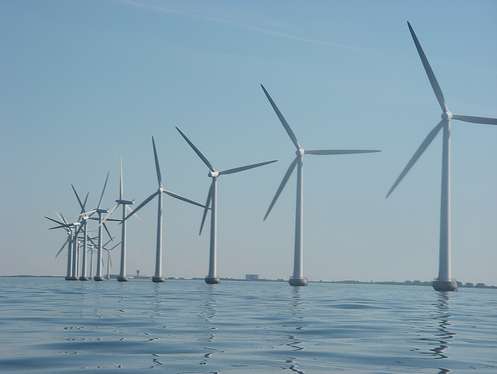Offshore wind power may yet not match the overall strength of onshore wind, but the industry is on course grow rapidly to become an €130 billion global market by 2020.
Global offshore wind market image via Roland Berger
A new report from industry consultants Roland Berger, “Offshore Wind Toward 2020,” concludes a combination of industry trends will soon make offshore wind cost competitive with other generation sources in many markets.
Europe is expected to continue dominating the global offshore wind industry, but the Asia Pacific and North American regions will soon represent significant market shares as technological innovation reduce many bottlenecks that have stymied project development to date.
Europe Continues To Dominate Global Markets
New turbines are expected to sprout from seas across the globe, but Europe will lead the charge, buoyed by ambitious national policy goals in multiple countries. The European Union has set 2020 targets of 35% electricity from renewables, with a 12% carve out for wind and 40 gigawatts (GW) installed offshore capacity.
So far, those targets have helped build 5GW offshore wind capacity, with new installations exceeding more than one offshore turbine per business day in 2012, equivalent to 10% of Europe’s annual wind energy installations. In many cases, actual generation from wind farms has exceeded expectations.
But current offshore output will be swamped by future additions – by 2020 reaching 4.5GW of new annual offshore wind capacity additions, worth more than €14 billion per year. Those estimates would more than triple annual capacity additions and double total investments for 2013, currently at 1.8GW and €7 billion respectively.
Growing Asia-Pacific, North American Markets
Just like a rising tide, the offshore wind market’s growth will raise boats outside of European waters. Asia Pacific is expected to reach 1.5GW of new annual capacity additions worth €4.8 billion by 2020, primarily focused in Japan, China, South Korea, and Taiwan. That exponential growth will dwarf current annual additions of 400 megawatts (MW) and €1.6 billion in investments.
Last but not least, North America is on course to finally join the global offshore market and capitalize upon the tremendous wind potential of its coastal waters. While annual capacity additions and annual investment are both near zero today, the report forecasts Canada, America, and Mexico will be home to 500MW annual capacity additions and €1.6 billion in total investment by 2020.
Industry Innovations Boost Cost Competitiveness
All these forecasts may seem optimistic considering significant bottlenecks in current technology, financing, and costs that have created a typical 7-10 year project development timeline, but Roland Berger predicts industry trends and market innovations will speed construction and boost cost competitiveness.
As more turbines are built, offshore wind farms will seek locations further from shore, solving the development challenges of limited space near coastlines and constrictive environmental laws. Projects further out to sea will then allow bigger farms to be built and encourage increased efficiencies in turbine manufacturing.
Offshore wind farm size/depth image via Roland Berger
In this scenario turbines will get bigger and more powerful, boosting overall project output. The report predicts the average offshore wind farm size will jump from 200MW today to 340MW in 2020, with average turbine capacity rising from 2-3MW today to 4-7MW.
Big Is Beautiful
Larger turbines embody the “big is beautiful” mantra, and their efficiencies of scale will drive industry cost-competitiveness with other forms of generation. Offshore wind capital expenditures are forecast to drop 6%, while operation and maintenance costs fall 14% and capacity factors rise 12%.
Offshore wind farm size/LCoE image via Roland Berger
Add it all up, and the levelized cost of energy (LCoE) from European offshore wind generation could fall 17% from current figures. This equals Europe’s current offshore wind LCoE of €13 cents per kilowatt-hour (kWh) dropping to €11ct/kWh by 2016 and €9ct/kWh by 2020 – making offshore wind competitive with all other forms of non-hydro renewable electricity.
European LCoE generation mix image via Roland Berger
Risks Remain, But Potential Is Clear
Siting new offshore wind projects in ever-deeper waters does, however, raise logistical problems for turbine installation and risks future growth. The report notes new vessels are now being specifically designed to install offshore turbines more efficiently, and the types of turbine foundations used will shift from gravity-based or monopile construction to jacket-style or floating foundations – all reducing installation times and project costs.
Overall, the challenges to offshore wind remain significant, but the potential is enormous and the imperative to build out this renewable energy resource is clear. “The offshore wind industry will become increasingly important in the years ahead,” said Marcus Weber of Roland Berger. “Transforming the energy system without this one central pillar would be difficult to imagine.”
This article was originally published on CleanTechnica. Reproduced with permission














